Nestle has applied for a patent for an infant formula based on potato protein microparticles. The company presents it as a naturally hypoallergenic infant formula that is suitable for infants with cow's milk protein allergy.
Nestle patents infant formula based on potato protein microparticles

Nestle has applied for a patent for an infant formula based on potato protein microparticles. The company presents it as a naturally hypoallergenic infant formula that is suitable for infants with cow's milk protein allergy.
Background
Human breast milk and breast feeding are considered to be the optimal form of nutrition for healthy infants during the first months of life. However, there is a need for nutritional sources that can be used in addition to breast milk.
Furthermore, not all infants can be breast fed and the needs of more vulnerable infants, such as preterm infants, cannot be achieved by their mother's milk, so there is also a need for alternatives to breast milk.
Nutritional compositions that satisfy the nutritional requirements of infants may be used as a substitute for or complement to human breast milk. Preferably, infant formulas should have an acceptable taste, and be hypoallergenic when targeted to infants who are allergic or at risk of allergy.
Infant formulas are typically formulated with cow's milk protein. For example, bovine whey protein and/or casein are often used as the protein source in infant formulas. However, some infants exhibit an allergy to cow's milk proteins, making such formulas unsuitable.
Allergies to cow's milk and to infant formulas containing cow's milk protein may be due to the differences between the proteins in cow's milk and those in human milk. The principal recognised cow's milk allergens are alpha-lactalbumin (aLA), beta-lactoglobulin (bLG) and bovine serum albumin (BSA).
To reduce allergenicity, cow's milk proteins may be hydrolysed (e.g. enzymatically) either partially or, in the case of products intended for the management of Cow's Milk Protein Allergy (CMPA), extensively.
However, such proteins must be highly processed to provide sufficient hydrolysis to reduce the risk of an allergic reaction.
Such processing may be viewed unfavourably with an increasing tendency to provide more natural diets, and a strong hydrolysis process also tends to have a negative impact on taste. In addition, the extensive processing increases the cost of the product formulas.
Alternatives to cow's milk protein may be used in nutritional compositions, for example soy and rice proteins.
Soy-based nutritional compositions are not recommended by the European Society for Paediatric Gastroenterology, Hepatology and Nutrition (ESPGHAN) for infants (0-12 months), because of the risk of a cross allergic response.
Rice-base nutritional compositions require the addition of numerous free amino acids to provide the correct amino acid profile for infant formulas, due to the incomplete natural amino acid distribution in rice proteins. This increases cost and may provide the resulting formula with a less palatable taste. Furthermore, rice proteins are generally insoluble and require at least partial hydrolysis for solubilisation.
Infant formulas may be formulated entirely from free amino acids for infants with severe cases of multiple allergies. However, ESPGHAN guidelines indicate that such formulas should not be used as a first line solution in the case of cow's milk protein allergic infants. Furthermore, overprescription of amino acid based formulas adds to the cost burden on national health systems as amino acid based formulas are even more expensive than extensively hydrolysed formulas.
Accordingly, there is a significant need for nutritional compositions for infants that comprise less potential allergens, and preferably which require minimal processing, have good taste and have low cost. In particular, there is a need for infant formulas that are suitable for administration to infants with cow's milk protein allergy. There is also a related need for processes for preparing such infant formulas.
Summary
The Nestle patent describes an infant formula based on potato protein, which is naturally absent in the major allergens found in milk and soy. Accordingly, the described product may provide a naturally hypoallergenic infant formula that is suitable for infants with cow's milk protein allergy.
In addition, the patent describes an improved process for producing an infant formula based on potato protein, wherein the process utilises potato protein in the form of potato protein microparticles. This enables the processing during production of mixtures comprising an increased Total Solids concentration and provides improved spray drying.
The use of potato protein in an infant formula is advantageous as it has a well balanced amino acid profile, which is closer to that of human milk than rice or soy protein. Accordingly, less addition of free amino acids is required to provide a composition with the required nutritional profile, which renders the resulting product more cost effective and gives it a more palatable taste.
Moreover, as a result of their lower allergen profile, the potato protein components do not require extensive hydrolysis, which provides significant benefits in terms of cost and for the development of the infant, because the intact or slightly hydrolysed proteins facilitate improved gut maturation.
The need for an emulsifier may be reduced or removed for an infant formula based on potato protein, because the potato protein itself may provide any necessary emulsifier properties. In addition, use of potato protein provides for good acceptance, for example in terms of taste and texture of the infant formula.










